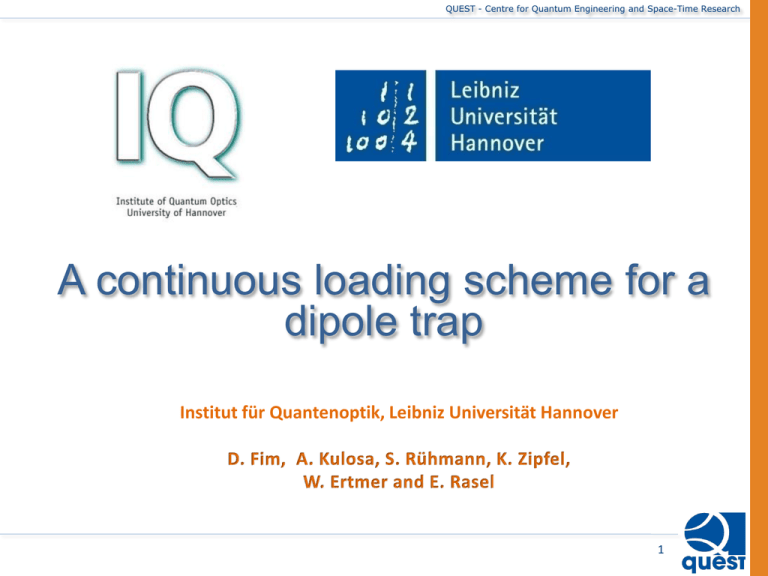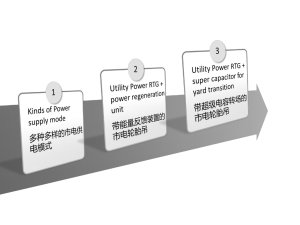A Magnesium optical lattice clock
advertisement

QUEST - Centre for Quantum Engineering and Space-Time Research A continuous loading scheme for a dipole trap Institut für Quantenoptik, Leibniz Universität Hannover 1 QUEST - Centre for Quantum Engineering and Space-Time Research A magnesium frequency standard n(24Mg: 1S0 → 3P1 )= 655 659 923 839 730 (47) Hz T T Limited by the doppler effet 1st order Dominika Fim – RTG 1729 2 QUEST - Centre for Quantum Engineering and Space-Time Research A magnesium frequency standard Stability of clocks: 1st order Doppler broadening vanish improves with a higher number of atoms Dominika Fim – RTG 1729 3 QUEST - Centre for Quantum Engineering and Space-Time Research Outline • Optical cooling of magnesium – Stepwise loading scheme of dipole traps • Limitations – Continuous loading scheme of dipole traps • Comparison of the loading schemes • Improvements • Conclusion Dominika Fim – RTG 1729 4 QUEST - Centre for Quantum Engineering and Space-Time Research Optical cooling of magnesium Singlet Triplet 469 nm 1 3 2 (3s3d) 3D (3s3p) 1P1 383 nm 26 MHz 285 nm 78 MHz (3s2) 1S 0 2 1 (3s3p) 3P 0 457 nm 36 Hz Singlet-MOT: 3mK intercombination transition: Interkombination Light at the magic wavelength ionize low photon scattering rate 3D states atoms from Triplet-MOT: 1mK density limitation! Dominika Fim – RTG 1729 5 QUEST - Centre for Quantum Engineering and Space-Time Research S-MOT Singlet-MOT: Number of atoms: 3 ∙ 109 Temperature: 3mK Decay of the number of atoms: Singlet 1 3 2 (3s3d) 3D 108 1/s R - loading rate = 5 ∙ α - one-body losses Ʈ = 1/α ̴ 17s Limitation: one-body loss Triplet (3s3p) 1P1 285 nm 78 MHz 2 1 (3s3p) 3P 0 (3s2) 1S0 Dominika Fim – RTG 1729 6 QUEST - Centre for Quantum Engineering and Space-Time Research T-MOT Number of atoms: T-MOT Triplet-MOT: Number of atoms: ̴ 108 Temperature: 1mK Decay of the number of atoms: Sequential loading scheme: Trap time Atoms in the dipole trap: 3P2 state limited by binary collisions and density α - one-body losses β - two-body losses Ʈ = 1/α ̴ 1 s (decay: 3P1 → 1S0 ) Two-body loss at high number of atoms Singlet tdec / s Triplet 1 3 2 (3s3d) 3D (3s3p) 1P1 383 nm 26 MHz 285 nm 78 MHz 2 1 (3s3p) 3P 0 (3s2) 1S0 Dominika Fim – RTG 1729 457 nm 36 Hz 7 QUEST - Centre for Quantum Engineering and Space-Time Research Continuous- loading scheme Triplet Singlet 1 3 2 (3s3d) 3D (3s3p) 1P1 383 nm 26 MHz 285 nm 78 MHz (3s2) 1S Dominika Fim – RTG 1729 0 2 1 (3s3p) 3P 0 457 nm 36 Hz 8 QUEST - Centre for Quantum Engineering and Space-Time Research Comparison of the loading schemes Lifetime of the dipole trap continuous τ=4,5 s sequential τ=1,1 s of atoms N Number Atomzahl Atomzahl of atoms N Number loading: dipole trap capture time / s loading time / s • Loading rates are equal: 1.2∙103 1/s • Continuous loading: limited by lifetime Ʈ = 4.5 s • Sequential: saturation at Ʈ = 1.1 s Dominika Fim – RTG 1729 9 QUEST - Centre for Quantum Engineering and Space-Time Research Enhancement of the loading rate → Density limitation: high photon scattering rate (reabsorption, inelastic collisions) → Optimization only for the continuous loading scheme Higher loadingefficiency due to higher Intensity • spatial expansion of the T-MOT (limited by temperature) → low detuning → high intensity Number of atoms in the dipole trap W00= 3.1 mm 11 mm Saturation on 3P2 → 3D3 Dominika Fim – RTG 1729 10 QUEST - Centre for Quantum Engineering and Space-Time Research •small number of atoms: exponential decay • high number of atoms: loss attributed to binary collisions number of atoms in the dipole trap Decay curve Decay 5 10 4 10 3 10 2 10 0 2 4 6 8 10 12 14 16 time / s Raise of Temperature → elastic collisions rather unlikely → inelastische collisions Dominika Fim – RTG 1729 11 QUEST - Centre for Quantum Engineering and Space-Time Research Inelastic collisions Ʈ = 1/α = 4.2 s A high energy difference requires a low distance → rather unlikely 0,024 eV (3s4s) 1S 0 Triplett (3s3d) 3D 2,7 eV 1 3 2 Due to the collision both atoms change their atomic state (3s3p) P → for the low energy12 difference (3s3p) P 0 collision at high distances possible 1 + 3P0 (3s2)1S0 + (3s4s)1S0 Energie Singulett 3P 0 1 3 1S 0 + 3P0 (3s2) 1S0 Dominika Fim – RTG 1729 12 QUEST - Centre for Quantum Engineering and Space-Time Research Results Number of atoms: Stepwise: Continuous: Optimized continuous: 1.1 ∙ 103 4.5 ∙ 103 3 ∙105 Loading rate: Stepwise/Continuous: 1.2 ∙ 103 1/s Optimized continuous: 1.3 ∙ 105 1/s -> the dipole trap loading rate was increased by two orders of magnitude: 3 ∙ 105 atoms in the trap!! Dominika Fim – RTG 1729 13 QUEST - Centre for Quantum Engineering and Space-Time Research …due to the continuous loading scheme ...we were able to trap magnesium atoms in an optical lattice Singulett Triplett (3s3d) 3D (3s3p) 1P1 285 nm 78 MHz 1 3 2 383 nm 26 MHz 2 1 (3s3p) 3P 0 457 nm (3s2) 1S0 36 Hz 10.000 Atome in 3 s !! Dominika Fim – RTG 1729 14 QUEST - Centre for Quantum Engineering and Space-Time Research Conclusion • Presented a continuous loading scheme for 3P0 which avoids density limitation by introducing additional loss channel to T-MOT • increased loading rate dipole trap by two orders of magnitude • Number of atoms in the dipole trap is limited by two-body loss collisions 25.03.2010 Dominika Fim – RTG 1729 15 QUEST - Centre for Quantum Engineering and Space-Time Research Group leader… Prof. Dr. Wolfgang Ertmer Prof. Dr. Ernst M. Rasel Dominika Fim – RTG 1729 16 QUEST - Centre for Quantum Engineering and Space-Time Research …and the magnesium Team 17






